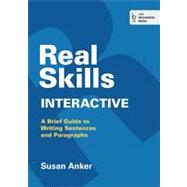
Make a Point
Support Your Point
Make a Plan
Write a Draft
4. Improving Your Paragraph: How to Make It the Best It Can Be Understand What Revision IsGet FeedbackImprove Your SupportCheck the Arrangement of Your IdeasTime OrderSpace OrderOrder of ImportanceTitle Your ParagraphCheck for the Four Basics of a Good Paragraph5. Developing Your Paragraph: Different Ways to Present Your IdeasNarrationGuided Practice: NarrationGuided Outline: NarrationWrite a Narration ParagraphIllustrationGuided Practice: IllustrationGuided Outline: IllustrationWrite an Illustration ParagraphDescriptionGuided Practice: DescriptionGuided Outline: DescriptionWrite a Description ParagraphProcess AnalysisGuided Practice: Process AnalysisGuided Outline: Process AnalysisWrite a Process-Analysis ParagraphClassificationGuided Practice: ClassificationGuided Outline: ClassificationWrite a Classification ParagraphDefinitionGuided Practice: DefinitionGuided Outline: DefinitionWrite a Definition ParagraphComparison and ContrastGuided Practice: Comparison and ContrastGuided Outline: Comparison and ContrastWrite a Comparison-and-Contrast ParagraphCause and EffectGuided Practice: Cause and EffectGuided Outline: Cause and EffectWrite a Cause-and-Effect ParagraphArgumentGuided Practice: ArgumentGuided Outline: ArgumentWrite an Argument Paragraph6. Moving from Paragraphs to Essays: How to Write Longer PapersEssay StructureWrite an EssayNarrow Your TopicWrite a Thesis StatementSupport Your Thesis Statement and Write Topic SentencesMake a PlanWrite, Revise, and EditPart Three: Grammar, Punctuation, and Mechanics7. The Parts of Speech: A Brief ReviewNounsPronounsPersonal Pronounssubject pronounsobject pronounspossessive pronounsIndefinite PronounsOther Types of Pronounsreflexive and intensive pronounsrelative pronounsinterrogative pronounsdemonstrative pronounsreciprocal pronounsVerbsAction VerbsLinking VerbsMain Verbs and Helping VerbsAdjectivesAdverbsPrepositionsConjunctionsCoordinating ConjunctionsSubordinating ConjunctionsInterjections8. Complete Sentences: Key Parts to Know Understand What a Sentence IsSubjectsSubject NounsSubject PronounsSimple and Complete SubjectsSingle and Plural SubjectsPrepositional PhrasesVerbsComplete ThoughtsSix Basic English Sentence PatternsLonger SentencesCompound SentencesComplex SentencesCompound-Complex Sentences9. Fragments: Sentences That Are Missing a Key PartUnderstand What Fragments AreFind and Correct FragmentsTrouble Spot 1: Fragments That Start with a Prepositional PhraseTrouble Spot 2: Fragments That Start with a Dependent WordTrouble Spot 3: Fragments That Start with an –ing Verb Trouble Spot 4: Fragments That Start with to and a VerbTrouble Spot 4: Fragments That Start with an Example or Explanation10. Run-Ons and Comma Splices: Two Sentences Joined IncorrectlyUnderstand What Run-Ons and Comma Splices AreFind and Correct Run-Ons and Comma SplicesAdd a Period or a SemicolonAdd a Comma and a Coordinating ConjunctionAdd a Subordinating Conjunction (Dependent Word)11. Subject-Verb Agreement Problems: Subjects and Verbs That Do Not MatchUnderstand What Subject-Verb Agreement IsFind and Correct Errors in Subject-Verb AgreementThe Verb Is a Form of Be, Have, or DoWords Come between the Subject and the VerbThe Sentence Has a Compound SubjectThe Subject Is an Indefinite PronounThe Verb Comes before the Subject12. Verb-Tense Problems: The Past Tense and the Past ParticipleUnderstand Regular Verbs in the Past TenseUnderstand Irregular Verbs in the Past TenseUnderstand Four Very Irregular Verbs Understand the Past ParticiplePast Participles of Regular VerbsPast Participles of Irregular VerbsUse the Past Participle CorrectlyPresent-Perfect TensePast-Perfect TensePassive versus Active VoiceVerb-Tense Reference Chart13. Other Grammar Concerns: Problems with Pronouns and ModifiersPronouns Make Pronouns Agree with Their Antecedentsindefinite pronounscollective nounsMake Pronoun References ClearUsing the Right Pronoun Casesentences with more than one subject or objectpronouns used in comparisonswho versus whomMake Pronouns Consistent in PersonAdjectives and Adverbs Choose between Adjectives and AdverbsAdjectives and Adverbs in ComparisonsGood, Well, Bad, and BadlyMisplaced and Dangling Modifiers Misplaced Modifiers Dangling Modifiers 14. Style, Word Choice, and Spelling: Writing Effective SentencesAvoid Choppy Sentences Coordination coordinating conjunctionssemicolonsSubordination Balance Parallel IdeasParallelism in Pairs and ListsParallelism in ComparisonsParallelism with Certain Paired WordsAvoid Common Word-Choice Problems Vague WordsSlangWordy LanguageClichésSexist LanguageUse Commonly Confused Words CorrectlyFollow These Steps to Better Spelling 15. Punctuation and CapitalizationCommascommas between items in a seriescommas in compound sentencescommas after introductory wordscommas around adjective clausescommas with quotation markscommas in addressescommas in datescommas with namescommas with yes or no Apostrophesapostrophes to show ownershipapostrophes in contractionsQuotation Marksquotation marks for direct quotationsno quotation marks for indirect quotationsquotation marks for certain titlesSemicolonColonParenthesesDashHyphenCapitalizationcapitalization of sentencescapitalization of names of specific people, places, dates, and thingscapitalization of titlesThe New copy of this book will include any supplemental materials advertised. Please check the title of the book to determine if it should include any access cards, study guides, lab manuals, CDs, etc.
The Used, Rental and eBook copies of this book are not guaranteed to include any supplemental materials. Typically, only the book itself is included. This is true even if the title states it includes any access cards, study guides, lab manuals, CDs, etc.